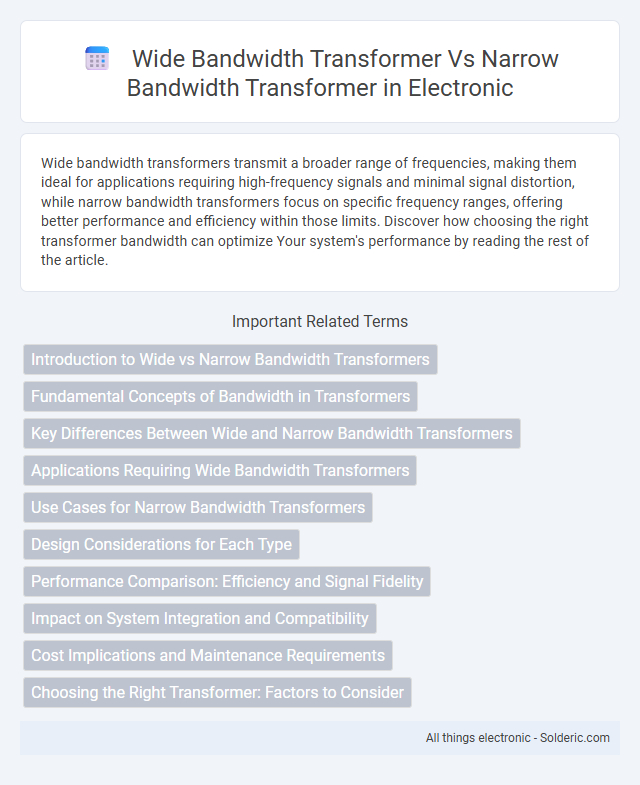Wide bandwidth transformers transmit a broader range of frequencies, making them ideal for applications requiring high-frequency signals and minimal signal distortion, while narrow bandwidth transformers focus on specific frequency ranges, offering better performance and efficiency within those limits. Discover how choosing the right transformer bandwidth can optimize Your system's performance by reading the rest of the article.
Comparison Table
| Feature | Wide Bandwidth Transformer | Narrow Bandwidth Transformer |
|---|---|---|
| Frequency Range | Broad frequency spectrum (e.g., 10 kHz to 1 GHz) | Limited, focused frequency range (e.g., 50 Hz to 60 Hz) |
| Applications | RF communication, broadband amplifiers, signal processing | Power distribution, audio systems, instrumentation |
| Core Material | Ferrite, air-core for reduced losses at high frequencies | Silicon steel or laminated cores optimized for low-frequency efficiency |
| Size & Weight | Generally smaller and lighter due to high-frequency design | Larger and heavier due to thicker cores and windings |
| Efficiency | High efficiency at high frequencies, lower at low frequencies | High efficiency at low frequencies, not suitable for high frequencies |
| Impedance Matching | Designed for wideband impedance matching | Designed for narrowband impedance matching |
| Cost | Higher due to specialized materials and construction | Lower cost, mass-produced for power applications |
Introduction to Wide vs Narrow Bandwidth Transformers
Wide bandwidth transformers support a broader range of frequencies, making them ideal for applications requiring high-frequency signals such as broadband communication and RF systems. Narrow bandwidth transformers focus on specific frequency ranges, offering greater efficiency and signal integrity at those targeted frequencies, often used in audio or power applications. Your choice depends on whether your system prioritizes versatility across frequencies or optimized performance for a particular frequency band.
Fundamental Concepts of Bandwidth in Transformers
Wide bandwidth transformers are designed to efficiently transfer signals across a broad frequency range, utilizing materials and winding techniques that minimize losses and maintain impedance consistency. Narrow bandwidth transformers focus on a specific frequency or narrow range, optimizing core and coil parameters to reduce distortion and enhance signal clarity within that limited spectrum. Understanding bandwidth in transformers involves analyzing frequency response, core material permeability, and winding inductance to achieve the desired performance for applications such as audio systems, RF circuits, or power transmission.
Key Differences Between Wide and Narrow Bandwidth Transformers
Wide bandwidth transformers offer the advantage of handling a broad range of frequencies, making them ideal for applications requiring versatility and signal integrity across diverse frequency spectrums. Narrow bandwidth transformers are optimized for specific frequency ranges, providing enhanced efficiency and reduced signal loss within that limited band, often used in specialized or tuning circuits. Your choice depends on whether the application demands frequency flexibility or targeted performance within a confined frequency range.
Applications Requiring Wide Bandwidth Transformers
Wide bandwidth transformers are essential in applications such as broadband communication systems, high-frequency measurement equipment, and radar technology, where signal integrity across a wide frequency range is critical. These transformers handle a broad spectrum of frequencies without significant loss or distortion, making them ideal for modern wireless and data transmission systems. Your choice of a wide bandwidth transformer ensures optimal performance in complex signal processing tasks requiring high fidelity and fast response times.
Use Cases for Narrow Bandwidth Transformers
Narrow bandwidth transformers are ideal for applications requiring precise frequency control such as radio communication, medical imaging, and signal processing, where minimizing interference and maximizing signal clarity are critical. They excel in resonance circuits, impedance matching, and narrowband filtering, ensuring high efficiency within a specific frequency range. Your choice of a narrow bandwidth transformer enhances performance in specialized environments by providing stable and targeted frequency response.
Design Considerations for Each Type
Wide bandwidth transformers require careful core material selection, such as ferrite or amorphous alloys, to minimize losses and maintain consistent performance over a broad frequency range. Narrow bandwidth transformers allow for more flexible core and winding designs optimized for maximum efficiency and minimal insertion loss within a limited frequency band. Precise impedance matching and thermal management are critical in both types to ensure optimal signal integrity and transformer longevity.
Performance Comparison: Efficiency and Signal Fidelity
Wide bandwidth transformers offer superior efficiency and signal fidelity across a broad frequency range, making them ideal for applications requiring minimal signal distortion. Narrow bandwidth transformers excel in targeted frequency bands with higher efficiency within that limited spectrum but may introduce more distortion outside their optimal range. Your choice depends on whether consistent performance over varying frequencies or peak efficiency in a specific band is the priority.
Impact on System Integration and Compatibility
Wide bandwidth transformers enhance system integration by supporting a broader frequency range, ensuring compatibility with diverse signal types and reducing the need for additional components. Narrow bandwidth transformers offer precise filtering and improved performance within a specific frequency range but may limit compatibility and require careful matching with system specifications. Your choice affects overall system flexibility and ease of integration in complex electronic environments.
Cost Implications and Maintenance Requirements
Wide bandwidth transformers typically incur higher initial costs due to advanced materials and complex manufacturing processes designed to handle a broader frequency range. Maintenance for wide bandwidth transformers often requires specialized expertise and diagnostic tools to monitor performance across diverse frequencies, potentially increasing ongoing expenses. In contrast, narrow bandwidth transformers generally feature lower upfront costs and simpler maintenance routines, benefiting from standardized components and less frequent adjustments.
Choosing the Right Transformer: Factors to Consider
Choosing the right transformer depends on your application's frequency range and signal integrity requirements. Wide bandwidth transformers support a broader spectrum of frequencies, ideal for high-speed data and broadband communication, while narrow bandwidth transformers deliver optimized performance at specific frequencies, enhancing efficiency and reducing noise in targeted applications. Consider bandwidth, insertion loss, and impedance matching to ensure your transformer meets the demands of your signal processing needs.
wide bandwidth transformer vs narrow bandwidth transformer Infographic

 solderic.com
solderic.com